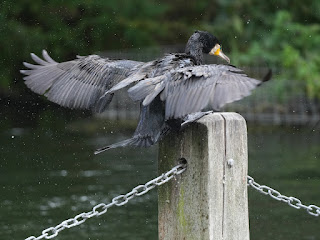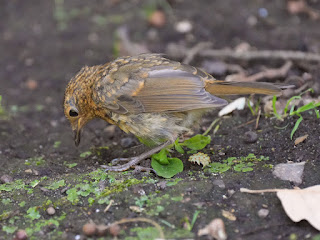A Wood Pigeon at the Round Pond chased two others around for no apparent reason.
There are two Young Robins in one stretch of the Flower Walk, evidently siblings. This is the one we've seen several times before, just beginning to get its first red feathers ...
... and there was another, more advanced, lurking in a bush where I couldn't get an unobstructed picture.
The young Starlings scavenging at the Lido restaurant are beginning to get their spotted adult feathers.
A Carrion Crow on the next table was making the most of a small piece of cake.
The male Peregrine was on the tower. A tiny dot in the sky above turned out to be his mate circling high over the football fields.
A young Cormorant at the Serpentine island picked up a twig from an abandoned Coot nest and waved it around. Was this nesting behaviour kicking in early, or was it just playing? Cormorants do build nests in trees, though they also nest on the ground on rocky outcrops.
Another Cormorant jumped on to a post to dry its wings.
Canada Geese ejected from the Long Water by the furious Mute Swan retreated in good order.
The swans which tried to nest beside the boathouse still return to the spot to rest and preen. The railings protect them from dogs and children.
The Mallard family on the Round Pond were cruising briskly round the edge, threading their way through the swans.
The little Mandarin was amusing itself by pushing Feral Pigeons about.
This pair of Mandarins at the Vista is nothing to do with the family from the pond. Both are moulting and flightless at the moment. The drake, on the left here, is completely in eclipse but you can spot him from the pink tinge to his bill.
Incidentally, the little Mandarin is getting a hint of pink at the base of its bill, and it may be male. But it's much too early to be sure.
The usual fox was out on the lawn under the Henry Moore sculpture.
It was quite windy and few insects were visible. Red Admiral butterflies are strong flyers and there were a couple beside the Long Water ...
... and in the relative shelter of the Rose Garden a few hardy Buff-Tailed Bumblebees were feeding on the lamb's ears ...
... and catmint.
An interesting picture taken by Jabir Belmehdi near the Speke obelisk: a wasp dismantling a dead Buff-Tailed Bumblebee to provide food for the grubs in its nest. At first I thought it might be a Beewolf, but in fact it seems to be an ordinary Common Wasp and probably the bee was already dead from other causes.















%202025%201a,.jpg)



%20having%20second%20helping%202025%201a.jpg)



















%202025%201a.jpg)

%202025%201a.jpg)







%202025%202a.jpg)




%202025%201a.jpg)

%202025%201a.jpg)

%202025%201a.jpg)
%202025%201a.jpg)
%202025%201a.jpg)
%202025%202a.jpg)
%202025%201a.jpg)
